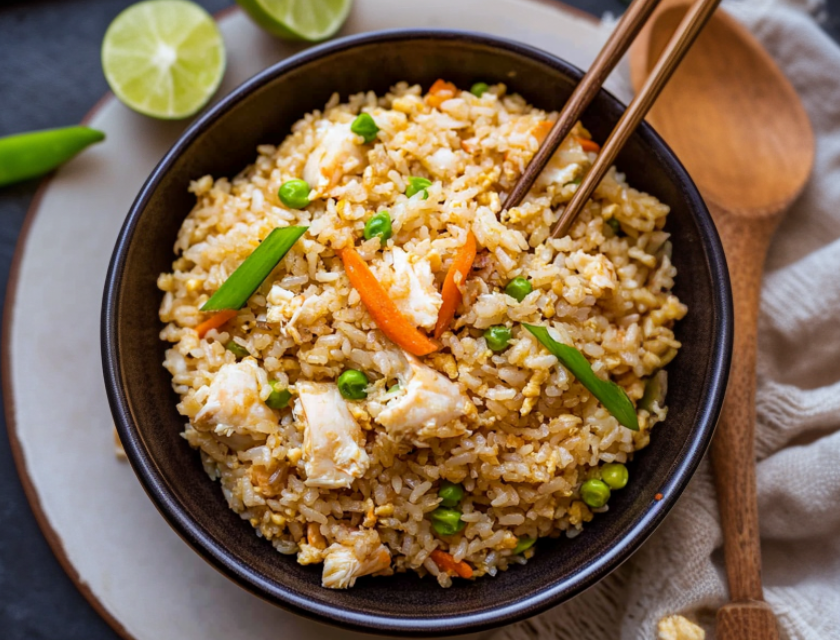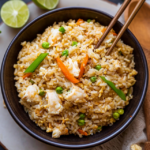Crab fried rice is a beloved dish in many Asian cuisines, particularly in Thai and Chinese cooking. Known for its balance of delicate flavors, fluffy rice, and succulent crab meat, this dish is both simple and luxurious. The combination of fresh aromatics, umami-rich seasonings, and sweet crab meat makes it a favorite for home cooks and restaurant-goers alike.

This dish is not only delicious but also highly versatile. It can be customized to suit different tastes by adjusting the seasoning, adding vegetables, or incorporating heat with chili. Whether you’re making it as a quick weekday meal or for a special occasion, crab fried rice delivers both comfort and elegance in every bite.
Overview of Crab Fried Rice
Crab fried rice is a stir-fried dish made with pre-cooked rice, fresh lump crab meat, eggs, and seasonings such as fish sauce and soy sauce. It’s often finished with fresh herbs like scallions and cilantro, and a squeeze of lime to bring out its flavors.
The key to perfect fried rice lies in the technique. Using day-old rice ensures the grains remain separate, while high-heat cooking prevents sogginess. The order of ingredient addition also plays a crucial role in achieving the perfect texture and flavor balance.
Brief History and Cultural Significance
Fried rice has been a staple in Chinese cuisine for centuries, with its origins tracing back to the Sui Dynasty (589–618 AD). It was created as a way to repurpose leftover rice, preventing food waste while creating a flavorful dish.
As Chinese culinary influence spread across Southeast Asia, different variations of fried rice emerged. In Thailand, crab fried rice became a standout dish, often served in high-end restaurants and street food stalls alike. The Thai version is typically seasoned with fish sauce, white pepper, and lime, giving it a distinct tangy and aromatic flavor.
In Chinese cuisine, fried rice is often made with soy sauce, Shaoxing wine, and scallions. The Cantonese-style crab fried rice tends to be lighter in color but equally rich in flavor. Across different regions, the dish has been adapted to local preferences, incorporating regional ingredients such as chili paste, curry powder, or additional vegetables.
Preparation Phase & Tools to Use
Essential Tools and Equipment
- Wok or Large Skillet – A wok is preferred due to its ability to distribute heat evenly, ensuring quick and high-heat cooking. However, a large non-stick or cast-iron skillet can also be used.
- Spatula or Wok Turner – A flat-bottomed spatula helps in quickly stirring and flipping the rice without breaking the grains.
- Mixing Bowls – Useful for prepping ingredients beforehand.
- Cutting Board and Sharp Knife – Necessary for chopping aromatics like garlic, ginger, and scallions.
- Measuring Spoons and Cups – Helps maintain consistency in seasoning.
Preparation Tips
- Use Day-Old Rice: Freshly cooked rice tends to be too moist and sticky. Using chilled, day-old rice prevents clumping and ensures a perfect texture.
- Choose Quality Crab Meat: Lump crab meat provides the best texture and flavor. Avoid imitation crab, as it lacks the sweetness of real crab.
- Prep Ingredients Before Cooking: Since stir-frying is a fast process, have everything chopped and measured beforehand.
- High Heat is Key: Cooking on high heat ensures a quick sear, preventing the rice from becoming soggy.
Ingredients List
- 3-4 tablespoons oil (vegetable, canola, or peanut oil)
- 2 tablespoons ginger, minced
- 2 cloves garlic, minced
- 4 cups cooked white rice (preferably jasmine or long-grain rice, day-old)
- 1/4 teaspoon white pepper
- 3 tablespoons fish sauce
- 1 tablespoon soy sauce
- 1 tablespoon Shaoxing wine (optional, for added depth)
- Salt, to taste
- 2 eggs, beaten
- 1 cup cooked lump crab meat (about half of a 16 oz. can or 225g)
- 2 scallions, chopped
- 1/4 cup cilantro, chopped
- Lime wedges, for serving
Step-by-Step Cooking Instructions
Step 1: Preparing the Ingredients
- Mince the ginger and garlic finely. Chop scallions and cilantro, keeping them separate.
- Beat the eggs in a bowl and set aside.
- Measure out the fish sauce, soy sauce, and white pepper to have them ready for quick cooking.
- If using canned crab, drain it well and gently flake it with a fork.
Step 2: Heating the Wok and Sautéing Aromatics
- Heat 3 tablespoons of oil in a wok over medium-high heat.
- Add the ginger first and stir for 30 seconds until fragrant.
- Add the garlic and cook for another 30 seconds, making sure it doesn’t burn.
Step 3: Cooking the Rice
- Increase the heat to high and add the cooked rice to the wok.
- Stir-fry for about 3 minutes, breaking up any clumps and ensuring the rice is evenly coated with the aromatics.
Step 4: Seasoning the Rice
- Add white pepper, fish sauce, soy sauce, and Shaoxing wine to the rice.
- Stir well to distribute the seasoning evenly. Taste and adjust salt if needed.
Step 5: Adding the Egg
- Push the rice to the sides of the wok, creating a well in the center.
- Pour the beaten eggs into the well and let them sit for a few seconds before scrambling.
- Once they are partially cooked, fold them into the rice, coating the grains evenly.
Step 6: Incorporating the Crab
- Spread the rice evenly in the wok again and gently add the crab meat.
- Stir-fry for another 1-2 minutes until the crab is heated through.
- Be careful not to overmix, as crab meat is delicate and can break apart.
Step 7: Finishing Touches and Serving
- Add the chopped scallions and cilantro and give it one final toss.
- Remove from heat and serve hot with lime wedges on the side.
Tips for the Best Crab Fried Rice
- Don’t Overcrowd the Wok: If making a large batch, cook in smaller portions to maintain high heat.
- Use a Neutral Oil: Avoid using strong oils like olive oil, which can alter the flavor.
- For Extra Flavor: Add a teaspoon of butter at the end for a silky finish.
- Make it Spicy: Toss in sliced Thai chili or drizzle with sriracha before serving.
- Pair it with a Sauce: Serve with chili oil, soy sauce, or a dash of vinegar for added complexity.
Best Side Dishes for Crab Fried Rice
Crab fried rice is a satisfying dish on its own, but pairing it with complementary side dishes can enhance the meal. Whether you’re looking for something crunchy, fresh, or light, here are some great options.
Asian-Inspired Side Dishes
- Cucumber Salad – A refreshing mix of thinly sliced cucumbers, rice vinegar, sesame oil, and sesame seeds. The crispness balances the soft texture of the rice.
- Steamed Bok Choy – Lightly steamed with a touch of soy sauce and garlic, this mild vegetable complements the rich flavors of the fried rice.
- Miso Soup – A warm and umami-packed broth with tofu and seaweed adds depth to the meal.
- Pickled Vegetables – Quick-pickled carrots, daikon, or cabbage provide a tangy contrast that enhances the flavors of the dish.
Refreshing & Light Side Dishes
- Mango Salad – A Thai-style salad with fresh mango, red onion, and a lime-fish sauce dressing offers a sweet and tangy contrast to the savory rice.
- Lettuce Wraps – Crisp lettuce leaves filled with grilled shrimp, tofu, or chicken add freshness and a crunchy texture.
- Edamame with Sea Salt – Lightly boiled or steamed soybeans sprinkled with sea salt make for a protein-rich, healthy side.
- Papaya Salad – A green papaya salad with a zesty lime and chili dressing brings a bright, crunchy element to the meal.
Fried and Crispy Side Dishes
- Spring Rolls – Crispy vegetable or shrimp spring rolls provide a satisfying crunch alongside the soft, fluffy fried rice.
- Tempura Vegetables – Lightly battered and fried, tempura zucchini, sweet potatoes, or mushrooms make a delicious side.
- Crispy Fried Tofu – A simple dish of golden-brown tofu cubes with a soy dipping sauce adds extra protein to the meal.
- Air-Fried Green Beans – Crunchy and seasoned with garlic, these green beans add a fun, healthier element to the plate.
Pairing crab fried rice with one or more of these side dishes creates a well-balanced and diverse meal, appealing to a range of tastes and textures.
Nutritional Information & Health Benefits
Crab fried rice is a well-balanced dish that provides a mix of protein, carbohydrates, and essential nutrients. However, it’s important to consider portion sizes and seasoning choices for a healthier version.
Key Nutritional Facts per Serving
- Calories: Moderate, depending on oil usage. Can be adjusted by reducing oil or using a non-stick pan.
- Protein: High due to the crab meat and eggs, making this a filling meal.
- Carbohydrates: Rice provides the main source of carbs, offering sustained energy.
- Fats: Primarily from the oil and crab meat. Using a lighter oil can reduce excess fat.
- Sodium: Fish sauce and soy sauce contribute to the sodium content. To lower it, opt for low-sodium soy sauce or adjust the seasoning.
- Vitamins & Minerals: Crab is rich in omega-3 fatty acids, vitamin B12, and selenium, supporting brain and heart health.
Health Benefits
- Good for Heart Health: The omega-3 fatty acids in crab meat can help reduce inflammation and support cardiovascular function.
- Boosts Immunity: Crab contains zinc and selenium, which are important for immune function.
- Supports Muscle Growth: With its high protein content, crab fried rice is excellent for muscle repair and growth.
- Promotes Healthy Digestion: Adding fiber-rich sides like vegetables and salads can improve digestion and nutrient absorption.
For a healthier version, consider using brown rice, reducing oil, and incorporating more vegetables to increase fiber and nutrients.
Common Mistakes & How to Perfect the Recipe
While crab fried rice is simple to make, certain mistakes can affect the final result. Avoiding these pitfalls ensures the best texture and flavor.
Common Mistakes
- Using Freshly Cooked Rice – Fresh rice contains too much moisture, leading to a mushy texture. Always use day-old rice that has been refrigerated to help the grains stay separate.
- Not Cooking on High Heat – Stir-frying requires high heat to properly sear the rice and ingredients. Cooking on low heat can cause sogginess.
- Adding Too Much Sauce – While soy sauce and fish sauce add umami, too much liquid can make the rice sticky. Add in small amounts, tasting as you go.
- Overcooking the Crab Meat – Crab meat is delicate and only needs to be heated through at the end. Overcooking can make it dry and rubbery.
- Skipping the Lime Wedge – A squeeze of lime at the end enhances the dish with brightness and acidity, balancing the richness of the crab and seasonings.
Pro Tips for Perfect Crab Fried Rice
- Break Up the Rice Before Cooking – Use your hands or a fork to separate the grains before adding them to the wok.
- Stagger Ingredient Additions – Add ingredients in the correct order: aromatics first, then rice, seasoning, egg, and finally crab meat.
- Keep Stirring, but Not Too Much – Stir the rice enough to prevent burning, but avoid excessive stirring that could break the grains and make the dish mushy.
- Let the Egg Coat the Rice – Instead of scrambling the egg separately, pour it over the rice and mix it in gradually to create a light, creamy texture.
- Use the Right Oil – Neutral oils like peanut, canola, or vegetable oil are best. Avoid olive oil, which can overpower the dish’s flavors.
- Garnish Generously – Adding fresh cilantro and scallions right before serving brings an extra layer of aroma and flavor.

Crab Fried Rice
- Total Time: 25 minutes
- Yield: 4 servings 1x
Description
A quick and flavorful Crab Fried Rice recipe made with lump crab meat, fluffy rice, aromatic seasonings, and fresh herbs. Perfect for a quick meal or an impressive dish for guests.
Ingredients
- 3–4 tablespoons oil (vegetable, canola, or peanut oil)
- 2 tablespoons ginger, minced
- 2 cloves garlic, minced
- 4 cups cooked white rice (day-old jasmine or long-grain rice)
- 1/4 teaspoon white pepper
- 3 tablespoons fish sauce
- 1 tablespoon soy sauce
- 1 tablespoon Shaoxing wine (optional)
- Salt, to taste
- 2 eggs, beaten
- 1 cup cooked lump crab meat (about half of a 16 oz. can or 225g)
- 2 scallions, chopped
- 1/4 cup cilantro, chopped
- Lime wedges, for serving
Instructions
Step 1: Prepare the Ingredients
- Mince the ginger and garlic finely.
- Chop scallions and cilantro.
- Beat the eggs in a small bowl.
- If using canned crab, drain and gently flake it with a fork.
Step 2: Heat the Wok and Sauté Aromatics
- Heat 3 tablespoons of oil in a wok or large skillet over medium-high heat.
- Add the ginger and cook for 30 seconds until fragrant.
- Stir in the garlic and cook for another 30 seconds, ensuring it doesn’t burn.
Step 3: Cook the Rice
- Turn the heat to high and add the cooked rice, breaking up any clumps.
- Stir-fry for 3 minutes to evenly coat the rice with aromatics.
Step 4: Season the Rice
- Sprinkle in white pepper, fish sauce, soy sauce, and Shaoxing wine.
- Mix well and taste, adjusting salt if needed.
Step 5: Add the Egg
- Push the rice to the sides of the wok, creating a well in the center.
- Pour the beaten eggs into the well and let them cook slightly before scrambling.
- Fold the eggs into the rice until fully incorporated.
Step 6: Add the Crab
- Gently stir in the lump crab meat and cook for 1-2 minutes, just until heated.
- Be careful not to overmix to keep the crab meat intact.
Step 7: Final Touches & Serving
- Add the chopped scallions and cilantro and give it a quick toss.
- Remove from heat and serve immediately with lime wedges on the side.
Notes
- For the best texture, use day-old rice stored in the refrigerator.
- Adjust seasoning based on your taste preference.
- To add spice, mix in sliced Thai chilies or drizzle with sriracha.
- For extra richness, finish with a teaspoon of butter before serving.
- Prep Time: 15 minutes
- Cook Time: 10 minutes
- Category: Main Dish
- Method: Stir-fry
- Cuisine: Thai/Chinese
Nutrition
- Serving Size: 1 plate
- Calories: 350
- Sugar: 1g
- Sodium: 800mg
- Fat: 10g
- Saturated Fat: 2g
- Unsaturated Fat: 6g
- Fiber: 2g
- Protein: 20g
- Cholesterol: 120mg


Leave a Comment